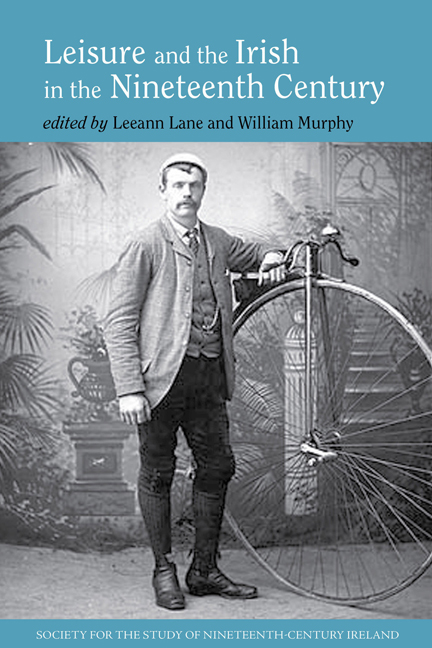Book contents
- Frontmatter
- Contents
- List of Figures and Tables
- Introduction
- Leisure and Associational Culture
- Leisure Spaces
- Leisure in Literature
- Leisure, Tourism and Travel
- 9 From Drogheda to Jerusalem, and a Riot: The Travels of Thomas Brodigan of Piltown, 1845–1846
- 10 ‘Bad roads will absolutely nip in the bud the new development’: Cycling Tourism in Ireland in the Late Nineteenth and Early Twentieth Centuries
- Leisure and Female Élites
- Notes on Contributors
- Index
9 - From Drogheda to Jerusalem, and a Riot: The Travels of Thomas Brodigan of Piltown, 1845–1846
from Leisure, Tourism and Travel
- Frontmatter
- Contents
- List of Figures and Tables
- Introduction
- Leisure and Associational Culture
- Leisure Spaces
- Leisure in Literature
- Leisure, Tourism and Travel
- 9 From Drogheda to Jerusalem, and a Riot: The Travels of Thomas Brodigan of Piltown, 1845–1846
- 10 ‘Bad roads will absolutely nip in the bud the new development’: Cycling Tourism in Ireland in the Late Nineteenth and Early Twentieth Centuries
- Leisure and Female Élites
- Notes on Contributors
- Index
Summary
Introduction
Although travel to and in Ireland in the eighteenth and nineteenth centuries, whether for reasons of scientific and social research, literary inspiration or leisurely picturesque pleasure, has been extensively discussed, the travellers who went out from Ireland and reported back from the corners of the globe have not been the subject of the same level of study.
Admittedly, some attention has been paid to a limited number of intrepid individuals, such as the Earl of Charlemont in the 1740s and 1750s, Viscount Valentia in 1802–6 and the Earl of Belmore in the 1810s, but there were many other travellers to whom little or no attention has been given. It is not possible here to give a global account, but it may suffice to illustrate the broader picture by commenting on one region that received numerous Irish visitors, the Middle East, particularly Egypt, the Holy Land and Syria. Many went to those areas under conditions of leisurely curiosity although that began to change after the defeat of Napoleon in 1802 and the opening up of Egypt. Travellers increased in numbers and their travels, as they grew in extent and systematisation, began to gain a distinctly acquisitive character. Often this meant the peaceful acquisition of spiritual experience and historical knowledge, but with increasing frequency it came to mean the accumulation of antiquities. By the 1840s, the impact of tourism and the rapacity and vandalism of tourists in Egypt was being lamented.
Unsurprisingly perhaps, the earlier travellers, however bold and enterprising they may have been, tended to be of an aristocratic status and could afford the time and cost of the journey. Some explored in other capacities – for example, James Curtin (b. c.1797), the servant of the circus strongman turned Egyptologist, Giovanni Battista Belzoni. Curtin was often referred to by Belzoni and others as the ‘Irish lad’ and is to be identified with the ‘H.J. Curtin native of Limerick Ireland’ who left a large graffito with that wording, dated 6 June 1817, in the temple of Isis at Philae. Although Curtin remains an obscure figure he became one of the earliest travellers in Egypt, Nubia, the Sudan and the Middle East. He accompanied other travellers in the region such as Thomas Legh who remarked that Curtin's ‘zeal, fidelity, and knowledge of the Arabic language, were of the greatest use to me’.
- Type
- Chapter
- Information
- Leisure and the Irish in the Nineteenth Century , pp. 169 - 186Publisher: Liverpool University PressPrint publication year: 2016



